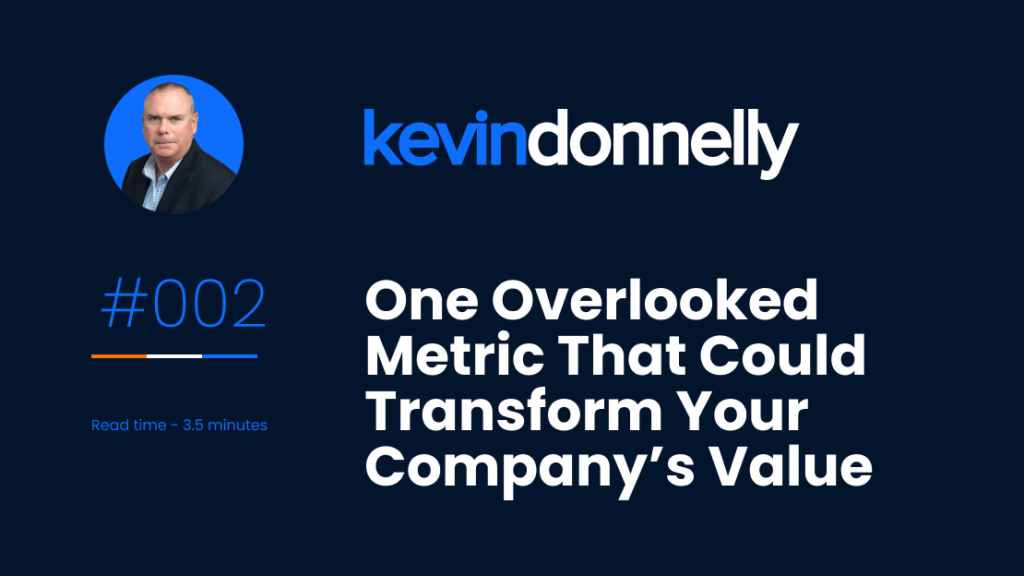Are you ready to meet your next level? Click here to book your free discovery call

You know gross margin impacts your profit, but have you considered the impact it has on the value of your company?
When assessing your company’s value, acquirers and investors will often scrutinize your gross profit margin. Gross profit margin is the difference between a company’s revenue and its cost of goods sold. In other words, it’s the profit a company makes from each unit of product or service sold after accounting for the cost of producing or delivering that unit but does not include other fixed expenses. For example, if a company sells a product for $100 and it costs $70 to produce and deliver it, the gross profit margin would be $30, or 30%.
A high gross profit margin is a crucial factor for investors and potential acquirers as it indicates that a company has established pricing power through marketing differentiation and possesses a competitive advantage. A strong competitive moat is an indicator of a company’s long-term sustainability, making it more appealing to potential investors.
When a company’s gross margin shrinks, it indicates to investors that the company may be competing on price. This is typically a sign that the business lacks a unique value proposition or marketing differentiation and that competing on price is the only way to attract customers. A shallow moat leaves the company vulnerable to competitive threats and makes it less appealing to potential acquirers.
24 vs. 6 Times Earnings
To illustrate the impact of gross margin on a company’s value, let’s compare two companies: Apple and Dell. Apple has a strong competitive advantage and a healthy gross margin, whereas Dell’s competitive moat is weaker and its gross margin is lower. In 2022 Apple’s average gross margin was 43%, compared to just 23% for Dell.
Apple has a highly differentiated brand and controls the buying experience through its Apple Stores. Additionally, Apple has invested in a range of high-margin subscription offerings, such as Apple TV and Apple Music. The market is willing to pay more than 24 times Apple’s 2023 earnings forecast, and the company has a market capitalization of over $2 trillion.
By contrast, Dell offers commoditized technology products, which puts them in a weaker competitive position, requiring them to compete on price and resulting in a lower gross margin. The market is only paying around six times Dell’s 2023 earnings estimates, giving it a total market capitalization of around $30 billion.
Just as gross margin impacts the world’s largest publicly traded companies, it also impacts smaller businesses. Ron Holt started Two Maids & a Mop, a residential cleaning company, in 2003. Holt ran a lean business and enjoyed healthy gross margins and a net profit margin of around 30%. Holt invested his earnings in differentiating his business from mom-and-pop cleaning services. He built a network of 12 locations across the southern U.S. and had plans to expand across the country.
Holt was curious about franchising as a business model and attended a Las Vegas conference where he had a chance encounter with Subway founder Fred DeLuca. Subway had more than 40,000 locations around the world at the time, so Holt asked DeLuca for his expansion advice.
DeLuca cautioned Holt about actioning every idea from his employees as his company got bigger. He told Holt, “Most of the time, employees bring you ideas to make their life easier, not to make you more money. Every time you make your employees’ lives easier, it comes at a cost.”
Armed with DeLuca’s advice, Holt grew Two Maids & a Mop from 12 to 91 locations and $40 million in revenue without seriously compromising his gross margin. In 2021 Holt sold his business to JM Family Enterprises for over ten times EBITDA.
Taking Action
Apart from raising prices or reducing input costs, an often overlooked approach to improving gross margin is to invest in carving out a point of differentiation for your business in the minds of your customers. When your customers see your business as unique, you are less likely to have to compete solely on price. Charge a premium for a differentiated product or service, and you’ll beef up your gross profit margin—and the value of your company.
When you're ready here's 3 ways I can help You Build Value For Your Company.
1. Let me work with you on your hiring.
If you're having trouble finding and keeping the right people to help grow your business I can show you what I did to go from 80 to 600 over a couple of years. Check out our free hiring assessment quiz...
2. Let's talk about what your business could be worth.
If you're like a lot of people thinking about what their end game is and want to know what your business is worth now and what it could be worth. Take my FREE Value Assessment and then we can talk.
3. Work With Me 1:1
If you'd like to work directly with me to increase the value of your company and establish your End Game plan, book a time to talk.
Similar Posts

Kevin Donnelly
December 28, 2024
TAM vs. Target
As you enter the fourth quarter of the year, you may be starting to think about your marketing plans for 2023. Terms like Total Addressable Market (TAM) and Target Market...

Kevin Donnelly
December 21, 2024
Ownership Has Its Privileges
Walk down Nashville’s Lower Broadway any night of the week, and you can hear aspiring artists belting out cover tunes from Elton John to Garth Brooks. In many cases, these...

Kevin Donnelly
December 14, 2024
Do Not Poke the Giant
On June 1, 2011, both Floyd’s Coffee Shops in Portland, Oregon were busier than usual. The regulars were elbowed out of the way by new customers visiting the store for...
